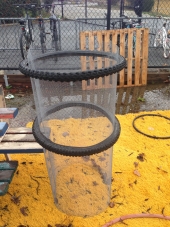hey what's going on?
i'm wondering what type of (especially nitrogen-rich) plants you've had growing in your mulch.
i'm getting about 16,000 pounds of shredded hardwood leaves dumped at this sunny, pastured lot soon, to start sculpting into garden beds.
here in hot and humid southern maryland, i'd like to be trying to get those leafy beds mostly converted into humus by the end of the year. issue being: i dont have much in the way of nitrogen-rich
compost activators around here.
i've seen humus form quickly in my leafy compost piles in my patch of the woods around here, with lots of worms and millipedes and stuff, eating through and leaving their bacteria-rich casts to work through the leaves in our wet, warm seasons. SO my main idea is to get lots of worm breeding happening in the garage on some of those shredded hardwood leaves, and then use these worm breeding bins to "inoculate" my leafy piles with the worms' bacterial casts, raising up the nitrogen in my piles.
after i get that top layer of compost on my piles though, i'm wondering what to sow. i've seen mulleins and dandelions grow in straight mulch around here, as well as certain types of grasses. what's your opinion on clovers/comfrey/oats making their way through these piles? what type of plants have you seen draw nutrients up from mulches before? i'm thinking i can grow lots of potatoes this year, and squashes too if i get some alpaca manure on those leaf piles. but i'd love to pull up nutrients with grasses/dynamic accumulators/nitrogen fixers that'll give structure to my beds. do you feel any hollow-stemmed grass like oats/barley/wheat/rice could work? i'd love to get a harvest of straw for my mushroom cultivation projects. let me know what you've observed!








